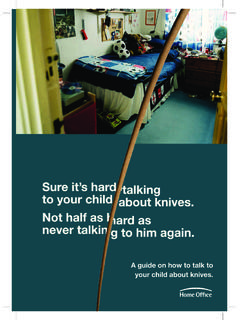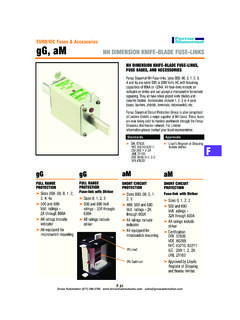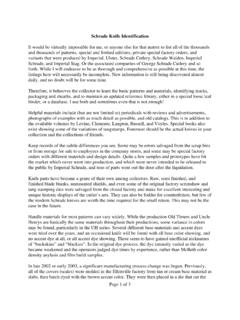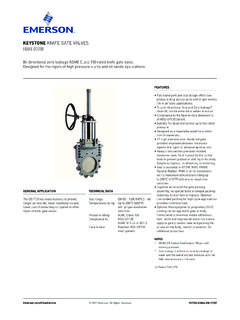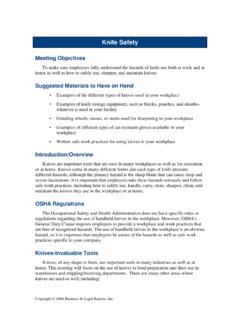Transcription of CARRYING A KNIFE TAKES AWAY CHOICES. DON’T LET …
1 01 CARRYING A KNIFE TAKES away CHOICES. DON T LET SOMEONE ELSE take away YOUR COUNT ME INCAMPAIGN0103 ABOUT THE CAMPAIGNC ount Me In is a joint initiative between the Department for Children, Schools and Families, Families Utd and the Home Office, which aims to increase young people s understanding, confidence, and belief in the fact that it is safer not to carry knives and similar weapons. Join schools across the UK in promoting Count Me In: Together We Can Stop KNIFE Crime and show that your school and your pupils are a positive force for stopping serious youth violence involving knives and other sharp weapons. WHO SHOULD GET INVOLVED AND WHY?Although this campaign is about getting young people to engage with this issue, schools can play a significant role in supporting and amplifying the messages to young people in a safe recognise that most schools are safe places and do not have an issue with KNIFE crime, but raising awareness amongst young people can still be beneficial.
2 That is why we need you to get involved. Schools are in an ideal position to raise the issue of KNIFE crime with large numbers of young people who may, at some point in their future, be faced with difficult decisions. This campaign is about prevention helping to inform and empower young people to make the right choice and support others to do the IS THIS GUIDE FOR?This guide can be used by all schools across England and Wales. It will be of most use to those working directly with pupils including: Teachers PSHE Teachers Year Heads Head TeachersRunning a session at your school can help your pupils: Understand and say no to the consequences of CARRYING knives and other sharp weapons. Talk about the issue. Not talking about something doesn t make it go away . Talking about violence and knives gives pupils choices to say no. Feel empowered to help stop KNIFE crime destroying lives. Stabbings and violent crime are issues affecting young people but they can help change this.
3 Feel encouraged to take easy and effective actions such as joining the campaign on Facebook and spreading the word to their friends, to someone they know who is involved in or has been affected by KNIFE crime, at school and/or in their local TO USE THIS GUIDEAs their teacher, you are most familiar with your pupils and the best way to run your lessons. This guide aims to support you with ways to communicate this sensitive issue to your pupils. It includes guidance for running assemblies and lessons on anti- KNIFE crime. It also includes an extensive list of resources from online games, videos, statistics and facts, detailed lesson guides, posters and real life stories to help engage your pupils. EASY DIRECTIONS TO ADDITIONAL RESOURCES There are many anti- KNIFE crime programmes that aim to inform and inspire local action and encourage young people not to carry a KNIFE or sharp weapon. This pack brings together the range of resources available in a simple guide on how to run a session at your school, share resources, information, ideas and expertise and reduce duplication or effort and materials.
4 All the resources have been subject to an approval process and sign posted to the most appropriate age group. You can read about some ideas for assembly and lesson plans and then follow the easy directions to access resources to use as part of your PLANYear group: 7 11 Cross curricular: PSHE and citizenship Timing: 15 minute presentation announcing the campaign and giving a brief introduction to your pupils. It is recommended that an assembly presentation is followed up by a half an hour lesson that week. See page 7 for the lesson guideline. INTRODUCTIONB ritain has lost too many teenagers to KNIFE crime both as victims and as offenders. Unfortunately, an increasing number of young people are CARRYING knives and getting involved in violent crime. Most young carriers are motivated by fear, but in tooling up ( CARRYING a KNIFE or weapon themselves) they increase the likelihood of becoming victims of KNIFE PRESENTATIONT oday we join schools across the UK in celebrating Count Me In: Together We Can Stop KNIFE Crime campaign.
5 This is a new campaign to show that our school and pupils are a positive force for stopping serious youth violence involving knives and other sharp weapons. Get their attention by showing a video: See the resources section on page 9 for a comprehensive list of videos on real life stories about KNIFE crime. If talking to 11 to 13 year olds, we recommend choosing a video that features a parent or guardian telling their story, as they are one of the main influences for children of that age. A good example, is the Say No To Knives campaign where a mother talks about her experience. The Kids Task Force Miss Dorothy primary school programme, is an excellent resource for this age group with fun characters and lesson plans to teach young people how to manage risk and stay safe. If talking to 14 to 16 year olds, we recommend choosing a harder hitting video. Research shows that young people react positively to real life stories and want to understand the potentially shocking consequences of CARRYING a KNIFE .
6 Tell them why they should be involved: Violent crime has fallen by a third in the last 10 years and serious youth violence remains rare. However, one life lost is one life too many. You have the choice to say no to CARRYING knives and all sharp weapons. Stabbings and violent crime by young people affect lives across the UK but together young people are choosing to stop it destroying lives. Because your family and friends are number one, don t take the risk of CARRYING a KNIFE or other sharp weapon. ADDITIONAL NOTESIf your school is planning on running classroom sessions then keep the presentation to a minimum. Simply introduce the campaign and show a video. It will spark your pupils interest and get them talking about KNIFE crime. If you are combining the lesson plan into the assembly then take an additional five minutes to tell your pupils how they can get involved in the OUTLINE06 LESSONGUIDE0307 LESSON GUIDEYear group: 7 11 Cross curricular: PSHE and citizenship Timing: 30 minutes lesson.
7 If you are not running an assembly to introduce the campaign then use the introduction in the assembly plan on page SESSIONSA traditional way of engaging young people about issues is through group sessions within classrooms. It gives young people an opportunity to hear different views about an issue and to talk about things that they might not want to discuss at home. This can also be an effective way of dealing with a range of issues over a number of sessions. GETTING STARTEDF irstly you can run through the key messages on why it is important that they get involved in Count Me In: Violent crime has fallen by a third in the last 10 years and serious youth violence remains rare. However, one life lost is one life too many. You have the choice to say no to CARRYING knives and all sharp weapons. Stabbings and violent crime by young people affect lives across the UK but together young people are choosing to stop it destroying lives.
8 Because your family and friends are number one, don t take the risk of CARRYING a KNIFE or other sharp weapon. Choose to play your part in stopping the violence. Even if you ve been involved in KNIFE crime and/or violent crime, you can break out of it. And there is something easy and effective everyone can setting goals for the lesson, a good way of getting started is by using a resource to get their attention (listed on page 9 in an easy to use guide). For example engage them with TV or viral advert to start a discussion about the issue of KNIFE crime. They can help young people to look at things from a different angle. There are also lots of real life stories that can be used as part of the discussion. (See the ambassadors section on page 8 for further information). You can also use materials for young people to take away at the managing a group discussion, you might need to set some ground rules particularly as sensitive issues are going to be discussed.
9 Make sure that everyone is given the opportunity to speak if they want to and that people s opinions are DISCUSSION TOPICSWhen talking about KNIFE crime, it is important that your pupils understand the facts and these can then be used to lead discussions with the group about the best ways to stop young people CARRYING knives. Download the Local Campaigners Toolkit and use the information to lead a discussion with your class on why people carry The pack has information on the facts, figures and essential information about KNIFE crime as well as why young people choose to carry a KNIFE and who they might be. ENCOURAGE YOUR PUPILS TO GET INVOLVEDRun through some ideas on how they can get involved in the campaign: Show you care by joining the Facebook page Count Me In: Together We Can Stop KNIFE Crime ( ). Spread the word to your friends, to someone you know who is involved in or has been affected by KNIFE crime and/or violent crime, through your school or in your community.
10 If you ve got a story to tell, share it. More voices mean a bigger difference. See the difference you re making, as the group grows of people like you who are saying no to knives and violence. Feel proud about the part you re playing in making life safer for you and your friends, and young people across the UK. We can celebrate together. PLAN OUTLINE08 LESSON GUIDE continuedTHE POWER OF REAL LIFE STORIESR esearch through Youth Offending Teams has shown young people are most affected by real testimonies of consequences of KNIFE crime. Hearing about the affects of KNIFE crime from young people or parents who have been involved with KNIFE crime can be a very powerful way to reach young people. Use real life stories (through videos, a local ambassador or case studies) for peer-to-peer messaging during information sharing environments such as workshops and assemblies to communicate withyour is a comprehensive list of real life stories in the resources table.



